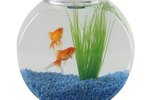
In most cases, chlorinating tap water is a good thing. Chlorine kills various organisms that can cause disease in humans. The amount of chlorine in tap water is harmless to humans, but it can kill a fish. You must not use water that contains chlorine in an aquarium.
Chlorine Burns
Chlorine is a very reactive chemical; in large amounts it can be used as a chemical weapon. Chlorine, even in amounts found in tap water, gives marine invertebrates and fish chemical burns. In fish, chlorine burns the gills. At the same time, it absorbs into the bloodstream and causes burns throughout the fish. It has a similar effect on invertebrates, who absorb it through their surfaces. These burns can cause serious damage to marine organisms.
Stress
Even with low exposure, chlorine can hurt aquarium fish. If it's not deadly, the constant pain from the damage it causes can cause stress. In fish, stress leaves them vulnerable to disease. Chlorine has a similar effect on invertebrates. If you accidentally add chlorinated water to your tank, immediately add dechlorinator. The signs of chlorine stress include fish darting around rapidly, gasping or jumping out of the tank. Invertebrates are more subtle. They may show stress by withdrawing tentacles or pulling themselves into their exoskeletons.
Releases Ammonia
Many municipalities use a preparation of chlorine called chloramine. Chloramine is ammonia and chlorine chemically bonded to each other. This compound is much more stable than pure chlorine. Some low-end dechlorinators do not address the excess ammonia released when the chlorine is neutralized, though. Make sure your water conditioners are able to neutralize both chlorine and chloramine. The labeling should say one way or the other.
Harbinger
One of the bigger problems with chlorine in a marine aquarium is that it's a sign you've used tap water. The safest means of making artificial seawater requires water purified by reverse osmosis, not dechlorinated tap water. Even if you neutralize chlorine and ammonia from tap water, tap water can still hold a number of problematic chemicals. These include things like phosphate, heavy metals and organic compounds. While these are almost certainly not at high enough levels to harm humans, marine organisms are extremely sensitive to water quality and require RO water as a starting point for their saltwater. You should use RO water -- not tap water -- to create your saltwater. You can get RO water by either filtering it yourself with an RO unit or from certain grocery and pet stores.
References
Photo Credits
-
Comstock Images/Comstock/Getty Images




